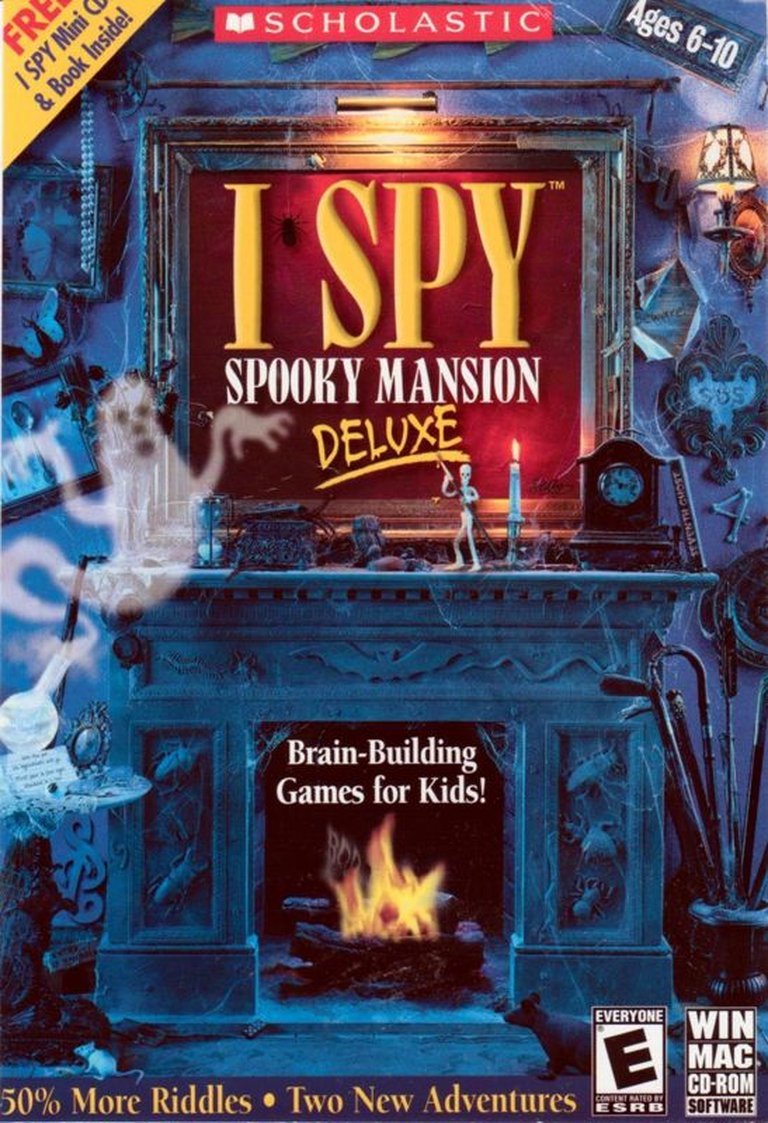- Release Year: 2005
- Platforms: Macintosh, Windows
- Publisher: Scholastic, Inc.
- Developer: Black Hammer Productions, Inc.
- Genre: Educational, Puzzle
- Perspective: 1st-person
- Game Mode: Single-player
- Gameplay: Hidden object, Mini-games, Point and click
- Setting: Haunted house
- Average Score: 88/100

Description
I Spy Spooky Mansion: Deluxe is an educational puzzle game where players explore a haunted mansion, solving riddles and hidden object puzzles to uncover secrets and escape. This upgraded version of the 1999 original features 50% more puzzles, multiple escape routes, and a secret room to discover, all designed to enhance problem-solving, vocabulary, and visual memory skills for children aged 6 to 10.
Gameplay Videos
I Spy Spooky Mansion: Deluxe Free Download
Reviews & Reception
mobygames.com (88/100): Average score: 88% (based on 5 ratings)
I Spy Spooky Mansion: Deluxe: A Comprehensive Review
Introduction
I Spy Spooky Mansion: Deluxe (2005) is a hidden-object puzzle game that stands as a testament to the enduring appeal of the I Spy franchise, blending educational value with spooky, immersive gameplay. Developed by Black Hammer Productions and published by Scholastic, this title is an enhanced version of the 1999 original, offering 50% more puzzles, three escape routes, and a secret room to uncover. Designed for children aged 6 to 10, the game challenges players with riddles, visual memory tasks, and logic puzzles—all wrapped in a haunted mansion setting. This review will dissect its development, narrative, gameplay, and legacy, arguing that I Spy Spooky Mansion: Deluxe is a masterclass in educational gaming that remains relevant decades later.
Development History & Context
Studio & Creators
Black Hammer Productions, a studio known for its educational and family-friendly titles, collaborated with Scholastic to bring I Spy Spooky Mansion: Deluxe to life. The game is based on the I Spy book series by Walter Wick and Jean Marzollo, which had already established a strong foothold in children’s literature. Key figures like Susan Gargiulo (Executive Producer) and Sam Nisson (Producer) oversaw the project, while Wick and Marzollo served as creative consultants, ensuring the game stayed true to the franchise’s core ethos.
Technological Constraints & Gaming Landscape
Released in 2005, I Spy Spooky Mansion: Deluxe arrived during a transitional period for educational gaming. The early 2000s saw a surge in CD-ROM-based educational titles, but the industry was also shifting toward digital distribution. The game’s use of the Director game engine—common for point-and-click adventures—reflects the era’s technological limitations, yet its point-and-click interface remains intuitive even by modern standards.
The gaming landscape of 2005 was dominated by console giants like the PlayStation 2 and Xbox, but PC-based educational games still held a niche market. I Spy Spooky Mansion: Deluxe competed with titles like Reader Rabbit and JumpStart, but its unique blend of horror-lite aesthetics and puzzle-solving set it apart.
Narrative & Thematic Deep Dive
Plot & Characters
The game lacks a traditional narrative, instead framing itself as an interactive treasure hunt. Players explore a haunted mansion, solving riddles to collect puzzle pieces and ultimately escape. The absence of a deep story is mitigated by the game’s atmospheric setting—a spooky mansion filled with eerie decorations and hidden objects.
Dialogue & Riddles
The riddles, read aloud by a narrator, are the game’s narrative backbone. Examples include:
– “I’m brown and round, but not a bun. I’m on a table, but not for fun. What am I?” (Answer: a bottle cap).
These riddles encourage wordplay and critical thinking, aligning with the game’s educational goals.
Themes
- Education Through Play: The game subtly teaches vocabulary, logic, and visual acuity.
- Mild Horror: The haunted mansion theme adds a layer of excitement without being frightening, making it accessible for young players.
Gameplay Mechanics & Systems
Core Gameplay Loop
Players navigate six rooms, each containing hidden objects tied to riddles. Solving these grants jigsaw puzzle pieces, which must be assembled to progress. The game offers three escape routes, encouraging replayability.
Innovations & Flaws
- Strengths:
- Intuitive UI: The point-and-click interface is child-friendly.
- Replayability: Multiple escape paths and hidden rooms extend playtime.
- Weaknesses:
- Technical Issues: Modern players report CD-ROM dependency and audio stuttering (as seen on MyAbandonware).
- Limited Progression: The lack of a story may deter players seeking deeper engagement.
World-Building, Art & Sound
Visual Direction
The game’s art style is cartoonish yet detailed, with a muted color palette that enhances the spooky atmosphere. Rooms like the library and attic are meticulously designed, hiding objects in plain sight—a hallmark of the I Spy series.
Sound Design
The soundtrack is minimal but effective, using creaky doors and distant whispers to maintain tension. The narrator’s voice acting is clear and engaging, crucial for delivering riddles.
Reception & Legacy
Critical & Commercial Reception
Critics praised the game’s educational value and replayability:
– Common Sense Media and Edutaining Kids gave it perfect scores, lauding its riddles and hidden-object gameplay.
– PCMag.com scored it 80%, noting its “fun factor” for kids and parents alike.
– Softonic was more critical, scoring it 60% but acknowledging its appeal to puzzle fans.
Legacy
I Spy Spooky Mansion: Deluxe influenced later hidden-object games, particularly in the educational sector. Its success led to sequels like I Spy Mystery (2006) and I Spy Fun House (2007). The game’s CD-ROM dependency has made it a niche title today, but its legacy endures among retro gaming enthusiasts.
Conclusion
I Spy Spooky Mansion: Deluxe is a brilliant example of how educational gaming can be both fun and challenging. Its riddles, atmospheric design, and replayability make it a standout title from the mid-2000s. While technical limitations hinder modern accessibility, its influence on puzzle and educational games is undeniable. For parents and educators seeking a timeless learning tool, this game remains a hidden gem.
Final Verdict: A near-perfect blend of education and entertainment, cementing its place in video game history.